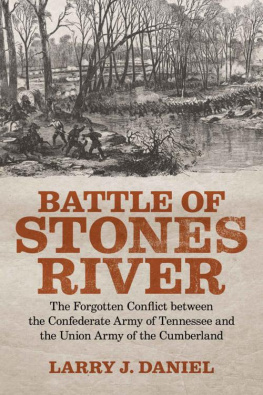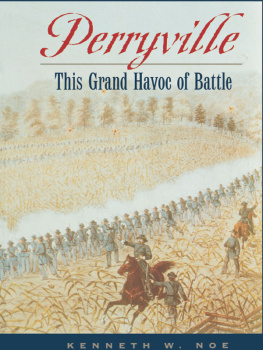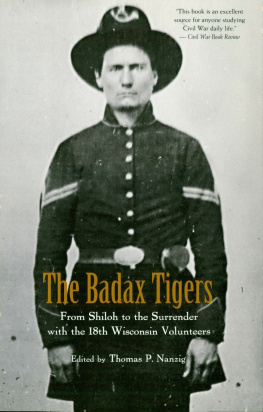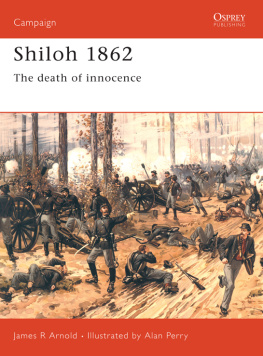The Battle That Changed the Civil War
SHILOH
SIMON & SCHUSTER PAPERBACKS
New York London Toronto Sydney
LARRY J. DANIEL

BOOKS BY LARRY J. DANIEL
Days of Glory: The Army of the Cumberland, 1861-1865
Shiloh: The Battle That Changed the Civil War
Island No. 10
Soldiering in the Army of Tennessee
Cannoneers in Gray

SIMON & SCHUSTER PAPERBACKS
Rockefeller Center
1230 Avenue of the Americas
New York, NY 10020
Copyright 1997 by Larry J. Daniel
All rights reserved, including the right of reproduction in whole or in part in any form.
SIMON & S CHUSTER PAPERBACKS and colophon are registered trademarks of Simon & Schuster, Inc.
For information about special discounts for bulk purchases, please contact Simon & Schuster Special Sales: 1-800-456-6798 or business@simonandschuster.com.
Designed by Edith Fowler
Maps by Jeff Ward
Manufactured in the United States of America
10 9 8 7 6 5
The Library of Congress has cataloged the hardcover edition as follows:
Daniel, Larry J.
Shiloh : the battle that changed the Civil War / Larry J. Daniel.
p. cm.
Includes bibliographic references and index.
1. Shiloh, Battle of 1862. I. Title.
E473.54.D36 1997
973.731dc21 96-51539 CIP
eISBN-13: 978-1-4391-2861-9
ISBN-10: 0-684-80375-5
ISBN-13: 978-0-684-83857-1 (Pbk)
ISBN-10: 0-684-83857-5 (Pbk)
www.SimonandSchuster.com
Acknowledgments
I AM DEEPLY INDEBTED to my friend Dr. Richard McMurry of Americus, Georgia, for his encouragement to write this book and his critique of the early chapters. Others who assisted in providing material or information that might otherwise have been missed include Gregg and Karel Lea Griggs of Celina, Ohio; Dr. Lawrence Hewitt, Hammond, Louisiana; Art Bergeron, Baton Rouge, Louisiana; Dr. Michael Parrish, Austin, Texas; and Bill Wagoner, Adamsville, Tennessee.
The staff of the Shiloh National Military Park was superb. Park Superintendent Woody Harrell, Chief of Interpretation Paul Hawke, and Park Rangers Brian K. McCutchen, Joe E. Davis, Floyd Rickman, and Don Todd deserve special mention. Park Historian Stacy Allen is mentioned several times in footnotes, but I would be remiss if I did not single him out for his patience, knowledge, and graciousness. Stacy probably knows more about the details of the Battle of Shiloh than any person living. He enthusiastically shared his vast knowledge, even when I called him at his home on several occasions. As partial repayment to the kindness of the staff, I have presented all of my research material (four feet of file folders) to the park.
My appreciation is extended to Civil War History for permission to expand upon a theme I first presented in their journal in December 1991.
Dedicated to GEORGE A. REAVES III Chief of Interpretation, Shiloh National Military Park 1975-1994
HIS HEART WILL ALWAYS BE AT SHILOH
Contents
List of Maps
1 Theater of Operations
2 The Shiloh Campaign
3 Pittsburg Landing and Vicinity
4 Prentiss Attacked 5:00-9:00 A.M.
5 Assault on Sherman 7:00-10:00 A.M.
6 Collapse of the Federal Right 10:30-11:30 A.M.
7 Fighting on the Confederate Left 11:00 A.M. -5:00 P.M.
8 Fighting on the Union Left 8:30-11:00 A.M.
9 The Hornets Nest 2:00-4:30 P.M., April 6
10 Confederate Right-Flank Sweep 2:00-4:00 P.M., April 6
11 Fall of the Sunken Road 4:45-6:00 P.M.
12 Grants Last Line 4:30-6:00 P.M.
13 Fighting on the Confederate Right 11:00 A.M. -12:00 Noon,
April 7
14 Advance of the Federal Right 10:00-11:00 A.M.
15 Water Oaks Pond 10:00 A.M. -2:00 P.M., April 7
Preface
THREE MODERN MONOGRAPHS have appeared on the Battle of Shiloh: Wiley Swords Shiloh: Bloody April, James Lee McDonoughs Shiloh: In Hell Before Night, and O. E. Cunninghams Shiloh and the Western Campaign of 1862, the last being an unpublished dissertation available to the public through University Microfilms of Ann Arbor, Michigan. Although not the first book on the subject, the present volume tells the story with a different twist. More attention is paid to the entire campaign, especially the role of politics. It is my contention that the battle cannot be viewed apart from the dynamics that occurred in the White House in Washington, D.C., and the Executive Mansion in Richmond, Virginia. The involvement of certain politicians, such as Elihu Washburne of Illinois and Henry Foote of Tennessee, is also explored.
Additional sources have been uncovered, and previously used material has been re-examined. I have also paid as much attention to maps as I have to the text. Measurably assisting in this task was a previously unpublished regimental-level map in the Albert Sidney Johnston Papers at Tulane University, as well as countless trips to the Shiloh National Military Park, where plaques and terrain were studied. The plaques were invaluable in establishing a standardized time for certain actions, and in supplying information not given in official reports. A close examination will reveal differences between the battle maps of this volume and those in previous works. In an effort to demythologize the events that occurred, contemporary drawings have been discounted in favor of photographs.
There are some new interpretations: the number of attacks upon the Hornets Nest, the effect of Daniel Ruggless artillery barrage, and Lew Wallaces march to the battlefield. Also examined are the larger imperatives: war aims, policies, diplomacy, the will to win, strategic planning and execution, and ultimate defeat and victory. By the time this volume appears, some twenty years will have lapsed since the last full-length book on this subject. New assessments by authors such as Steven Woodworth, Benjamin Cooling, and Archer Jones have been considered.
Leadership decisions are evaluated according to the information at hand. Commanders do not know outcomesonly options. Thus, Don Carlos Buell is defended for his slow advance upon Nashville, but criticized for his subsequent lethargy south of the city.
The heroes who emerge in the story are, by and large, uncommon namesAllen Waterhouse, Henry Allen, David Stuartsmall-unit commanders. The principal leaders receive mixed reviews. The campaign was Henry Hallecks to lose, and lose it he almost did. There is no question that the Federal army was surprised at Shiloh, and for that Ulysses S. Grant and William T. Sherman cannot escape substantial blame. Responsibility for the dismal performance of the Confederates during the first day of battle is placed upon the shoulders of Albeit Sidney Johnston and P. G. T. Beauregard. Yet all of these men at various times revealed a remarkable grasp of the issuesa far simpler task for those of us 135 years later.
The story is told in the format of different scenarios. This literary technique is to show that events did not occur in well-ordered sequence, as though one mind controlled the outcome. The reader is also given a sense of the geographic breadth of the events taking place. I have attempted to avoid lengthy biographical vignettes. The reader learns about the principal characters throughout the text. This, after all, is how we meet people in life; everything is not learned at first acquaintance.
Next page







